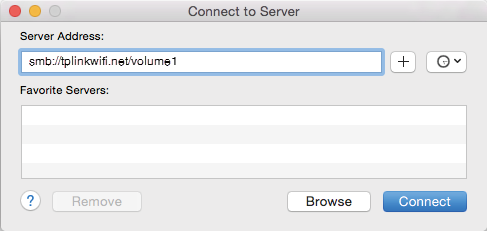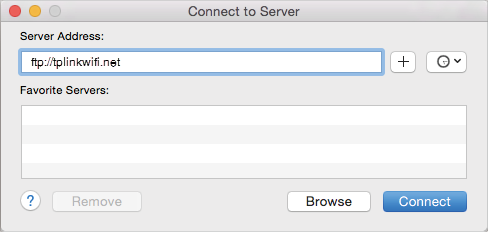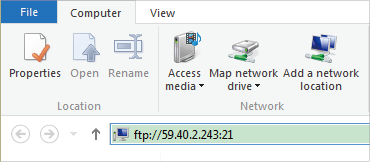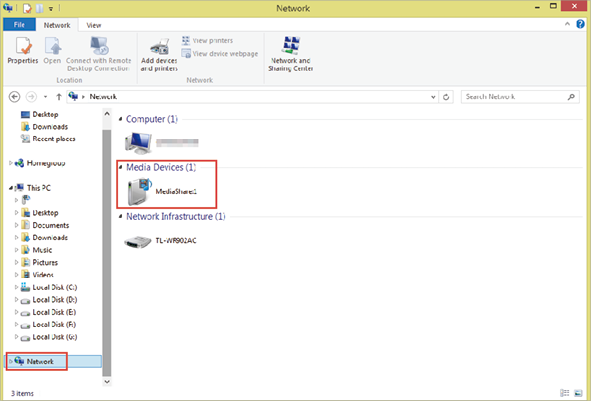TL-WR902AC V3 User Guide
- About This Guide
- Chapter 1 Get to Know About Your Router
- Chapter 2 Connect the Hardware
- Chapter 3 Set Up Internet Connection Via Quick Setup Wizard
- Chapter 4 Configure the Router in Wireless Router Mode
- Chapter 5 Configure the Router in Access Point Mode
- Chapter 6 Configure the Router in Range Extender Mode
- Chapter 7 Configure the Router in Client Mode
- Chapter 8 Configure the Router in Hotspot Router Mode
- FAQ
- Authentication
Chapter 4 Configure the Router in Wireless Router Mode
This chapter presents how to configure the various features of the router working as a standard wireless router.
It contains the following sections:
1.Visit http://tplinkwifi.net, and log in with the username and password you set for the router.
2.Go to Status. You can view the current status information of the router.

•Firmware Version - The version information of the router’s firmware.
•Hardware Version - The version information of the router’s hardware.
•LAN - This field displays the current settings of the LAN, and you can configure them on the Network > LAN page.
•MAC Address - The physical address of the router.
•IP Address - The LAN IP address of the router.
•Subnet Mask - The subnet mask associated with the LAN IP address.
•Wireless 2.4GHz/5GHz - This field displays the basic information or status of the wireless function, and you can configure them on the Wireless 2.4GHz/5GHz > Basic Settings page.
•Operation Mode - The current operation mode of the router.
•Wireless Radio - Indicates whether the wireless feature is enabled or not.
•Name (SSID) - The SSID of the network.
•Mode - The current wireless working mode in use.
•Channel Width - The current wireless channel width in use.
•Channel - The current wireless channel in use.
•MAC Address - The physical address of the router.
•WAN - This field displays the current settings of the WAN, and you can configure them on the Network > WAN page.
•MAC Address - The physical address of the WAN port.
•IP Address - The current WAN (Internet) IP Address. This field will be blank or 0.0.0.0 if the IP Address is assigned dynamically and there is no internet connection.
•Subnet Mask - The subnet mask associated with the WAN IP Address.
•Default Gateway - The Gateway currently used is shown here. When you use Dynamic IP as the internet connection type.
•DNS Server - The IP addresses of DNS (Domain Name System) server.
•System Up Time - The length of the time since the router was last powered on or reset.
Click Refresh to get the latest status and settings of the router.
2.1. WAN
1.Visit http://tplinkwifi.net, and log in with the username and password you set for the router.
2.Go to Network > WAN.
3.Configure the IP parameters of the LAN and click Save.
Dynamic IP
If your ISP provides the DHCP service, please select Dynamic IP, and the router will automatically get IP parameters from your ISP.
Click Renew to renew the IP parameters from your ISP.
Click Release to release the IP parameters.
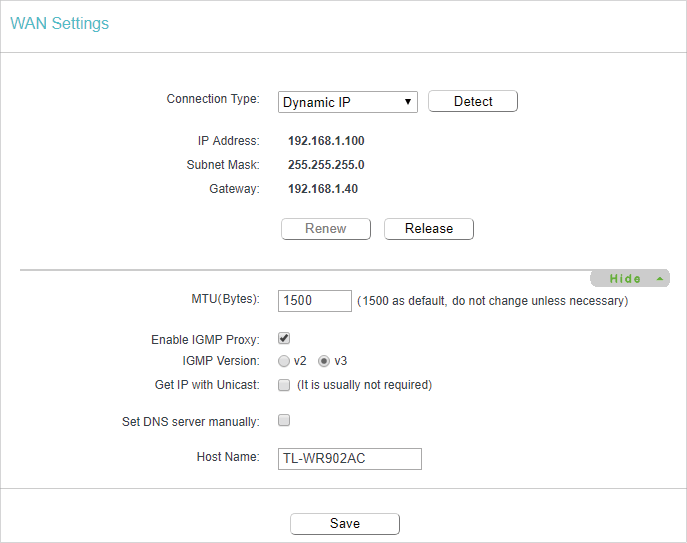
•MTU(Bytes) - The normal MTU (Maximum Transmission Unit) value for most Ethernet networks is 1500 Bytes. It is not recommended that you change the default MTU size unless required by your ISP.
•IGMP Proxy - Select to enable the IGMP Proxy feature if the IPTV service provided by the ISP is IGMP techonology-based.
•Get IP with Unicast DHCP - A few ISPs’ DHCP servers do not support the broadcast applications. If you cannot get the IP address normally, you can choose this option. (It is rarely required.)
•Set DNS server manually - If your ISP provides you one or two DNS addresses, select Set DNS server manually and enter the primary and secondary addresses. Otherwise, the DNS servers will be assigned dynamically from your ISP.
•Host Name - This option specifies the name of the router.
Static IP
If your ISP provides a static or fixed IP address, subnet mask, default gateway and DNS setting, please select Static IP.
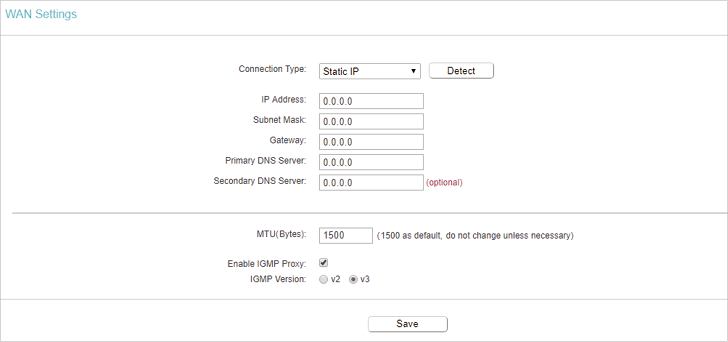
•IP Address - Enter the IP address in dotted-decimal notation provided by your ISP.
•Subnet Mask - Enter the subnet mask in dotted-decimal notation provided by your ISP. Normally 255.255.255.0 is used as the subnet mask.
•Gateway - Enter the gateway IP address in dotted-decimal notation provided by your ISP.
•Primary/Secondary DNS Server - (Optional) Enter one or two DNS addresses in dotted-decimal notation provided by your ISP.
•MTU(Bytes) - The normal MTU (Maximum Transmission Unit) value for most Ethernet networks is 1500 Bytes. It is not recommended that you change the default MTU size unless required by your ISP.
•IGMP Proxy - Select to enable the IGMP Proxy feature if the IPTV service provided by the ISP is IGMP techonology-based.
PPPoE/Russia PPPoE
If your ISP provides PPPoE connection, select PPPoE/Russia PPPoE.
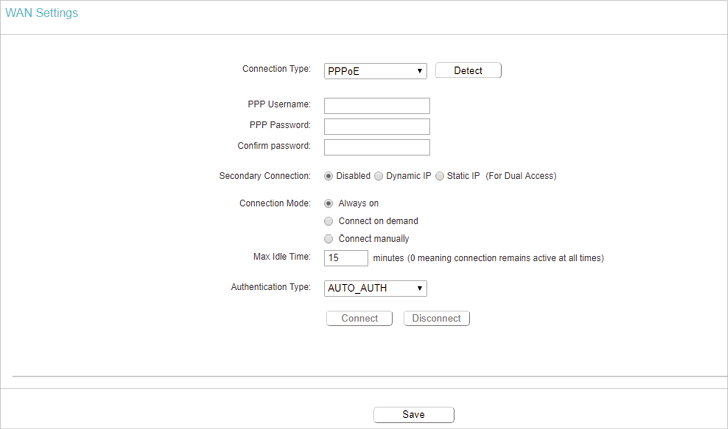
•PPP Username/Password - Enter the username and password provided by your ISP. These fields are case-sensitive.
•Confirm Password - Enter the Password provided by your ISP again to ensure the password you entered is correct.
•Secondary Connection - It’s available only for PPPoE connection. If your ISP provides an extra connection type, select Dynamic IP or Static IP to activate the secondary connection.
•Connection Mode
•Always On - Connect automatically after the router is connected.
•Connect on demand - In this mode, the internet connection can be terminated automatically after a specified inactivity period (Max Idle Time) and be re-established when you attempt to access the internet again. If you want to keep your internet connection active all the time, please enter 0 in the Max Idle Time field. Otherwise, enter the number of minutes you want to have elapsed before your internet access disconnects.
•Connect manually - You can click Connect/Disconnect to connect/disconnect immediately. This mode also supports the Max Idle Time function as Connect on demand mode. The internet connection can be disconnected automatically after a specified inactivity period (Max Idle Time) and not be able to re-establish when you attempt to access the internet again.
Note:
•Only when you have configured the system time on the System Tools > Time Settings page, will the time-based connecting function take effect.
•Sometimes the connection cannot be terminated although you have specified the Max Idle Time because some applications are visiting the internet continually in the background.
If you want to do some advanced configurations, please click Advanced.
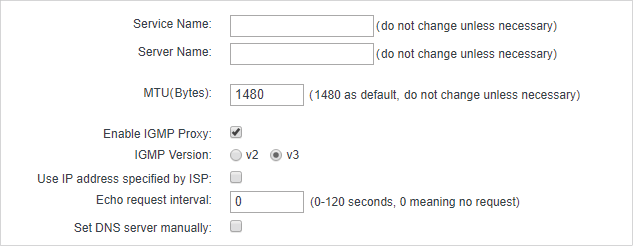
•Service Name/Server Name - The service name and server name should not be configured unless you are sure it is necessary for your ISP. In most cases, leaving these fields blank will work.
•MTU(Bytes)- The default MTU size is 1480 bytes. It is not recommended that you change the default MTU size unless required by your ISP.
•IGMP Proxy - Select to enable the IGMP Proxy feature if the IPTV service provided by the ISP is IGMP techonology-based.
•Use IP address specified by ISP - If your ISP does not automatically assign IP addresses to the router, please select Use IP address specified by ISP and enter the IP address provided by your ISP in dotted-decimal notation.
•Set DNS server manually - If your ISP does not automatically assign DNS addresses to the router, please select Set DNS server manually and enter the IP address in dotted-decimal notation of your ISP’s primary DNS server. If a secondary DNS server address is available, enter it as well.
BigPond Cable
If your ISP provides BigPond cable connection, please select BigPond Cable.
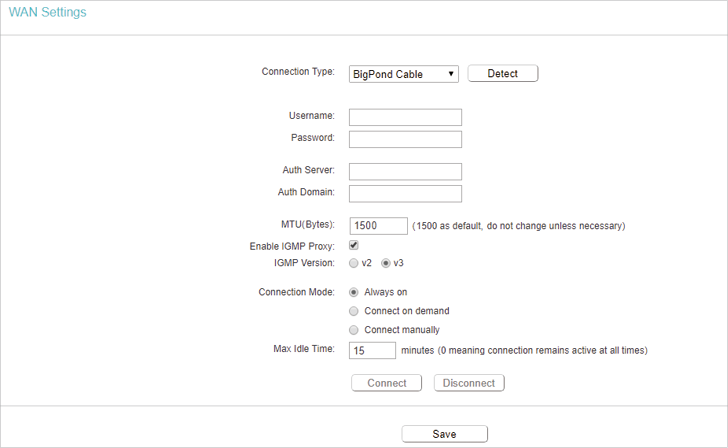
•Username/Password - Enter the username and password provided by your ISP. These fields are case-sensitive.
•Auth Server - Enter the authenticating server IP address or host name.
•Auth Domain - Type in the domain suffix server name based on your location.
•MTU(Bytes) - The default MTU size is 1480 bytes. It is not recommended that you change the default MTU size unless required by your ISP.
•IGMP Proxy - Select to enable the IGMP Proxy feature if the IPTV service provided by the ISP is IGMP techonology-based.
•Connection Mode
•Always On - Connect automatically after the router is connected.
•Connect on demand - In this mode, the internet connection can be terminated automatically after a specified inactivity period (Max Idle Time) and be re-established when you attempt to access the internet again. If you want to keep your internet connection active all the time, please enter 0 in the Max Idle Time field. Otherwise, enter the number of minutes you want to have elapsed before your internet access disconnects.
•Connect manually - You can click Connect/Disconnect to connect/disconnect immediately. This mode also supports the Max Idle Time function as Connect on demand mode. The internet connection can be disconnected automatically after a specified inactivity period (Max Idle Time) and not be able to re-establish when you attempt to access the internet again.
Note: Sometimes the connection cannot be terminated although you have specified the Max Idle Time because some applications are visiting the internet continually in the background.
L2TP
If your ISP provides L2TP connection, please select L2TP.
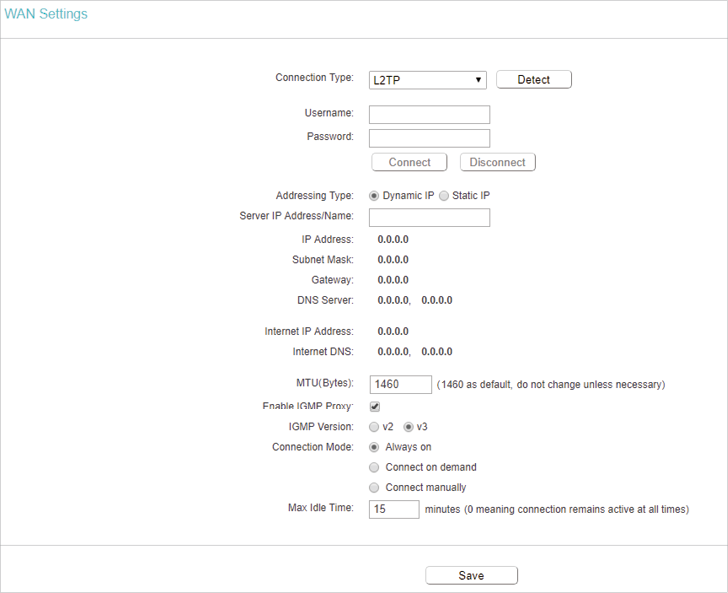
•Username/Password - Enter the username and password provided by your ISP. These fields are case-sensitive.
•Confirm Password - Enter the Password provided by your ISP again to ensure the password you entered is correct.
•Connect/Disconnect - Click this button to connect or disconnect immediately.
•Addressing Type - Select either as required by your ISP. If Static IP is selected, please enter the IP address, subnet marsk, gateway and DNS also provided by your ISP.
•Internet IP Address/ Internet DNS - The internet IP address and DNS server address assigned by L2TP server.
•MTU(Bytes) - The default MTU size is 1480 bytes. It is not recommended that you change the default MTU size unless required by your ISP.
•IGMP Proxy - Select to enable the IGMP Proxy feature if the IPTV service provided by the ISP is IGMP techonology-based.
•Connection Mode
•Always On - Connect automatically after the router is connected.
•Connect on demand - In this mode, the internet connection can be terminated automatically after a specified inactivity period (Max Idle Time) and be re-established when you attempt to access the internet again. If you want to keep your internet connection active all the time, please enter 0 in the Max Idle Time field. Otherwise, enter the number of minutes you want to have elapsed before your internet access disconnects.
•Connect manually - You can click Connect/Disconnect to connect/disconnect immediately. This mode also supports the Max Idle Time function as Connect on demand mode. The internet connection can be disconnected automatically after a specified inactivity period (Max Idle Time) and not be able to re-establish when you attempt to access the internet again.
![]() Note: Sometimes the connection cannot be terminated although you have specified the Max Idle Time because some applications are visiting the internet continually in the background.
Note: Sometimes the connection cannot be terminated although you have specified the Max Idle Time because some applications are visiting the internet continually in the background.
PPTP
If your ISP provides PPTP connection, please select PPTP.
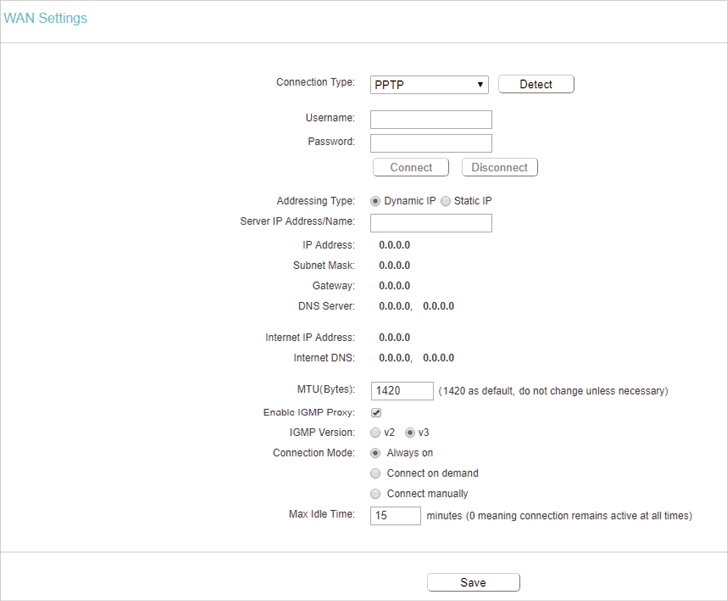
•Username/Password - Enter the username and password provided by your ISP. These fields are case-sensitive.
•Confirm Password - Enter the Password provided by your ISP again to ensure the password you entered is correct.
•Connect/Disconnect - Click this button to connect or disconnect immediately.
•Addressing Type - Select either as required by your ISP. If Static IP is selected, please enter the IP address, subnet marsk, gateway and DNS also provided by your ISP.
•Internet IP Address/ Internet DNS - The internet IP address and DNS server address assigned by L2TP server.
•MTU(Bytes) - The default MTU size is 1480 bytes. It is not recommended that you change the default MTU size unless required by your ISP.
•IGMP Proxy - Select to enable the IGMP Proxy feature if the IPTV service provided by the ISP is IGMP techonology-based.
•Connection Mode
•Always On - Connect automatically after the router is connected.
•Connect on demand - In this mode, the internet connection can be terminated automatically after a specified inactivity period (Max Idle Time) and be re-established when you attempt to access the internet again. If you want to keep your internet connection active all the time, please enter 0 in the Max Idle Time field. Otherwise, enter the number of minutes you want to have elapsed before your internet access disconnects.
•Connect manually - You can click Connect/Disconnect to connect/disconnect immediately. This mode also supports the Max Idle Time function as Connect on demand mode. The internet connection can be disconnected automatically after a specified inactivity period (Max Idle Time) and not be able to re-establish when you attempt to access the internet again.
![]() Note: Sometimes the connection cannot be terminated although you have specified the Max Idle Time because some applications are visiting the internet continually in the background.
Note: Sometimes the connection cannot be terminated although you have specified the Max Idle Time because some applications are visiting the internet continually in the background.
2.2. 3G/4G Settings
To use the 3G/4G function, you should first insert a 3G/4G USB modem into the 3G/4G USB port of the router. There is already much 3G/4G USB modem information embedded in th router. The USB modem parameters will be set automatically if the SIM/UIM card is supported by the router.
![]() Note: 3G/4G modem is only supported in some regions.
Note: 3G/4G modem is only supported in some regions.
1.Visit http://tplinkwifi.net, and log in with the username and password you set for the router.
2.Go to Network > 3G/4G Settings.
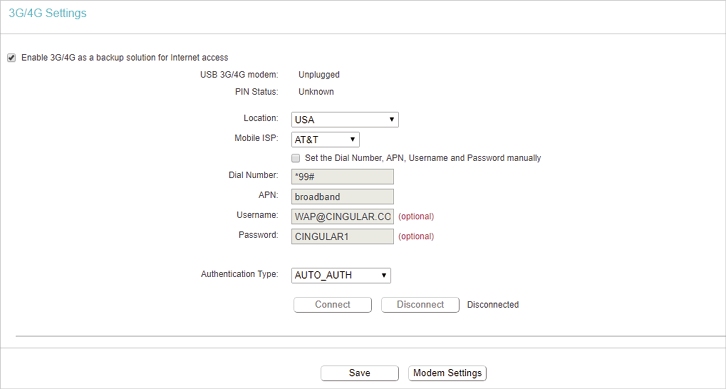
•Location - Please select the location where you are enjoying the 3G/4G service.
•Mobile ISP - Please select the ISP providing the 3G/4G service. The router will automatically fill in the default Dial Number and APN of that ISP.
•Username/Password - Enter the username and password provided by your ISP if any.
•Authentication Type - Some ISPs require authentication to access the internet. Please select Auto or consult your ISP.
•Auto - The router will have dynamic negotiation with the dialing server and the authentication type doesn’t need to be specified.
•PAP - Password Authentication Protocol. Select PAS if required by your ISP.
•CHAP - Challenge Handshake Authentication Protocol. Select CHAP if required by your ISP.
Click Advance to set advanced options.
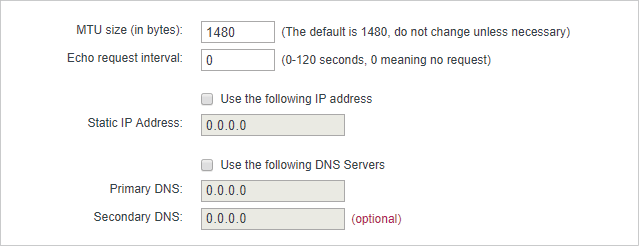
•MTU size (in bytes) - The typical MTU (Maximum Transmission Unit) size for 3G or 4G network is 1480 Bytes.
•Echo request interval - Enter a time interval value between 0 and 120 (in seconds) for which the router requests Access Concentrator to echo at every interval. The default value is 30. 0 means no detection.
•Use the following IP Address - Select this option and enter the IP address provided by your ISP.
•Use the Following DNS Servers - Select this checkbox and enter the DNS server address(es) in dotted decimal notation provided by your ISP. This 3G/4G connection will only use the specified DNS server(s).
If your 3G/4G USB modem cannot be identified by the router, please follow the steps below to have furtuer configuration.
1.Download a most recent 3G/4G USB modem configuration file from our website
www.tp-link.com.
2.Visit http://tplinkwifi.net, and log in with the username and password you set for the router.
3.Go to Network > 3G/4G Settings > Modem Settings.
4.Click Add New.

5.Click Choose File to locate the file you have downloaded and then click Upload.

1.Visit http://tplinkwifi.net, and log in with the username and password you set for the router.
2.Go to Network > LAN.
3.Configure the IP parameters of the LAN and click Save.

•MAC Address - The physical address of the LAN ports. The value can not be changed.
•IP Address - Enter the IP address in dotted-decimal notation of your router (factory default - 192.168.0.254).
•Subnet Mask - An address code that determines the size of the network. Normally 255.255.255.0 is used as the subnet mask.
•IGMP Snooping - The IGMP Snooping feature allows the router to only forward multicast traffic to ports that have requested them.
![]() Note:
Note:
•If you have changed the IP address, you must use the new IP address to log in.
•If the new IP address you set is not in the same subnet as the old one, the IP address pool in the DHCP Server will be configured automatically, but the Virtual Server and DMZ Host will not take effect until they are re-configured.
2.4. MAC Clone
1.Visit http://tplinkwifi.net, and log in with the username and password you set for the router.
2.Go to Network > MAC Clone.
3.Configure the WAN MAC address and click Save.

•WAN MAC Address - This field displays the current MAC address of the WAN port. If your ISP requires you to register the MAC address, please enter the correct MAC address in this field. Click Restore Factory MAC to restore the MAC address of WAN port to the factory default value.
•Your PC’s MAC Address - This field displays the MAC address of the PC that is managing the router. If the MAC address is required, you can click Clone MAC Address and this MAC address will be filled in the WAN MAC Address field.
![]() Note:
Note:
•You can only use the MAC Address Clone function for PCs on the LAN.
•If you have changed the WAN MAC address when the WAN connection is PPPoE, it will not take effect until the connection is re-established.
3.1. Basic Settings
1.Visit http://tplinkwifi.net, and log in with the username and password you set for the router.
2.Go to Wireless 2.4GHz/5GHz > Basic Settings.
3.Configure the basic settings for the 2.4GHz/5GHz wireless network and click Save.
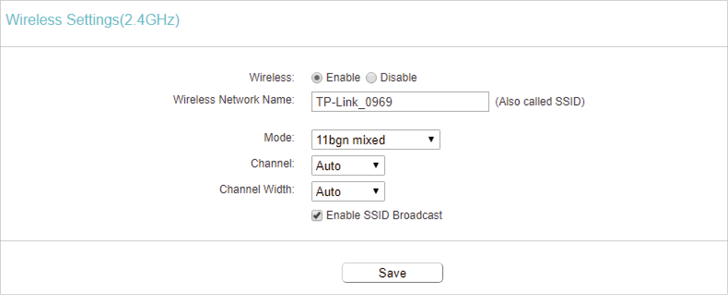
•Wireless Network Name - Enter a string of up to 32 characters. The default SSID is TP-Link_XXXX (XXXX indicates the last unique four numbers of each router’s MAC address). It is strongly recommended that you change your network name (SSID). This value is case-sensitive. For example, TEST is NOT the same as test.
•Mode - Select the desired mode. It is strongly recommended that you keep the default setting 11bgn mixed or 11a/n/ac mixed.
•Channel Width - Select any channel width from the drop-down list. The default setting is Auto, which can automatically adjust the channel width for your clients.
•Channel - This field determines which operating frequency will be used. The default channel is set to Auto. It is not necessary to change the wireless channel unless you notice interference problems with another nearby access point.
•Enable SSID Broadcast - If enabled, the router will broadcast the wireless network name (SSID).
3.2. WPS
WPS (Wi-Fi Protected Setup) can help you to quickly and securely connect to a network. This section will guide you to add a new wireless device to your router’s network quickly via WPS.
![]() Note: The WPS function cannot be configured if the wireless function of the router is disabled. Please make sure the wireless function is enabled before configuration.
Note: The WPS function cannot be configured if the wireless function of the router is disabled. Please make sure the wireless function is enabled before configuration.
1.Visit http://tplinkwifi.net, and log in with the username and password you set for the router.
2.Go to Wireless 2.4GHz/5GHz > WPS.
3.Follow one of the following three methods to connect your client device to the router’s Wi-Fi network.
Method ONE: Press the WPS Button on Your Client Device
1.Keep the WPS Status as Enabled and click Add device.

2.Select Press the button of the new device in two minutes and click Connect.
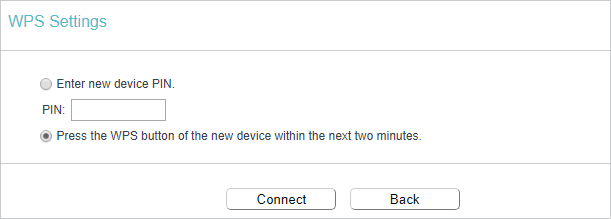
3.Within two minutes, press the WPS button on your client device.
4.A success message will appear on the WPS page if the client device has been successfully added to the router’s network.
Method TWO: Enter the Client’s PIN
1.Keep the WPS Status as Enabled and click Add device.

2.Select Enter new device PIN, enter your client device’s current PIN in the PIN filed and click Connect.
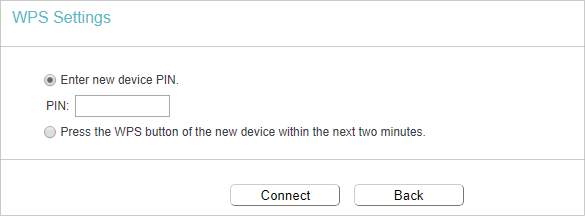
3.A success message will appear on the WPS page if the client device has been successfully added to the router’s network.
Method Three: Enter the Router’s PIN
1.Keep the WPS Status as Enabled and get the Current PIN of the router.

2.Enter the router’s current PIN on your client device to join the router’s Wi-Fi network.
3.3. Wireless Security
1.Visit http://tplinkwifi.net, and log in with the username and password you set for the router.
2.Go to Wireless 2.4GHz/5GHz > Wireless Security.
3.Configure the security settings of your 2.4GHz/5GHz wireless network and click Save.
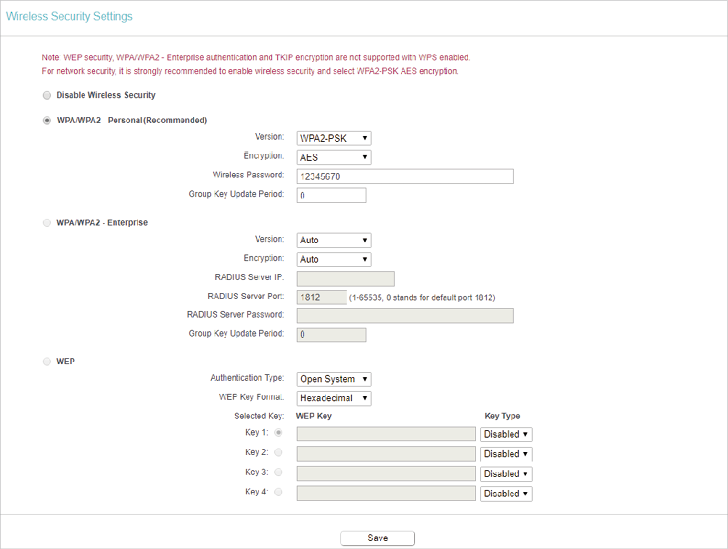
•Disable Wireless Security - The wireless security function can be enabled or disabled. If disabled, wireless clients can connect to the router without a password. It’s strongly recommended to choose one of the following modes to enable security.
•WPA/WPA2-Personal - It’s the WPA/WPA2 authentication type based on pre-shared passphrase.
•Version - Select Auto, WPA-PSK or WPA2-PSK.
•Encryption - Select Auto, TKIP or AES.
•Wireless Password - Enter ASCII or Hexadecimal characters. For Hexadecimal, the length should be between 8 and 64 characters; for ASCII, the length should be between 8 and 63 characters.
•Group Key Update Period - Specify the group key update interval in seconds. The value can be 0 or at least 30. Enter 0 to disable the update.
•WPA/WPA2-Enterprise - It’s based on Radius Server.
•Version - Select Auto, WPA or WPA2.
•Encryption - Select Auto, TKIP or AES.
•Radius Server IP - Enter the IP address of the Radius server.
•Radius Port - Enter the port that Radius server used.
•Radius Password - Enter the password for the Radius server.
•Group Key Update Period - Specify the group key update interval in seconds. The value should be 30 or above. Enter 0 to disable the update.
•WEP - It is based on the IEEE 802.11 standard.
•Type - The default setting is Auto, which can select Shared Key or Open System authentication type automatically based on the wireless client’s capability and request.
•WEP Key Format - Hexadecimal and ASCII formats are provided here. Hexadecimal format stands for any combination of hexadecimal digits (0-9, a-f, A-F) in the specified length. ASCII format stands for any combination of keyboard characters in the specified length.
•WEP Key (Password) - Select which of the four keys will be used and enter the matching WEP key. Make sure these values are identical on all wireless clients in your network.
•Key Type - Select the WEP key length (64-bit, 128-bit or 152-bit) for encryption. Disabled means this WEP key entry is invalid.
•64-bit - Enter 10 hexadecimal digits (any combination of 0-9, a-f and A-F. Null key is not permitted) or 5 ASCII characters.
•128-bit - Enter 26 hexadecimal digits (any combination of 0-9, a-f and A-F. Null key is not permitted) or 13 ASCII characters.
•152-bit - Enter 32 hexadecimal digits (any combination of 0-9, a-f and A-F. Null key is not permitted) or 16 ASCII characters.
3.4. Wireless MAC Filtering
Wireless MAC Filtering is used to deny or allow specific wireless client devices to access your network by their MAC addresses.
I want to:
Deny or allow specific wireless client devices to access my network by their MAC addresses.
For example, you want the wireless client A with the MAC address 00:0A:EB:B0:00:0B and the wireless client B with the MAC address 00:0A:EB:00:07:5F to access the router, but other wireless clients cannot access the router.
How can I do that?
1.Visit http://tplinkwifi.net, and log in with the username and password you set for the router.
2.Go to Wireless 2.4GHz/5GHz > Wireless MAC Filtering.
3.Click Enable to enable the Wireless MAC Filtering function.
4.Select Allow the stations specified by any enabled entries in the list to access as the filtering rule.
5.Delete or disable all entries if there are any entries already.
6.Click Add New and fill in the blanks.
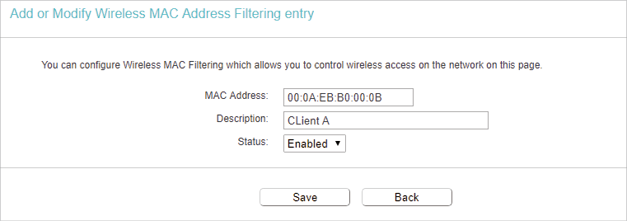
1 )Enter the MAC address 00:0A:EB:B0:00:0B/00:0A:EB:00:07:5F in the MAC Address field.
2 )Enter Client A/B in the Description field.
3 )Leave the status as Enabled.
4 )Click Save and click Back.
7.The configured filtering rules should be listed as the picture shows below.
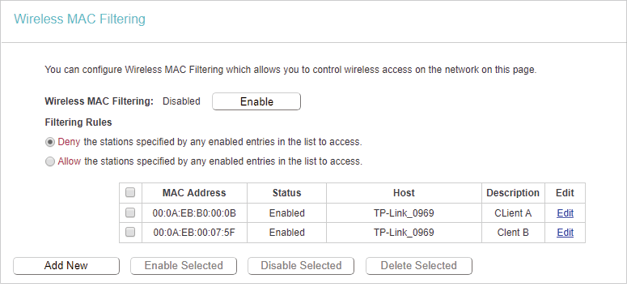
Done! Now only client A and client B can access your network.
3.5. Wireless Advanced
1.Visit http://tplinkwifi.net, and log in with the username and password you set for the router.
2.Go to Wireless 2.4GHz/5GHz > Wireless Advanced.
3.Configure the advanced settings of your wireless network and click Save.
![]() Note: If you are not familiar with the setting items on this page, it’s strongly recommended to keep the provided default values; otherwise it may result in lower wireless network performance.
Note: If you are not familiar with the setting items on this page, it’s strongly recommended to keep the provided default values; otherwise it may result in lower wireless network performance.
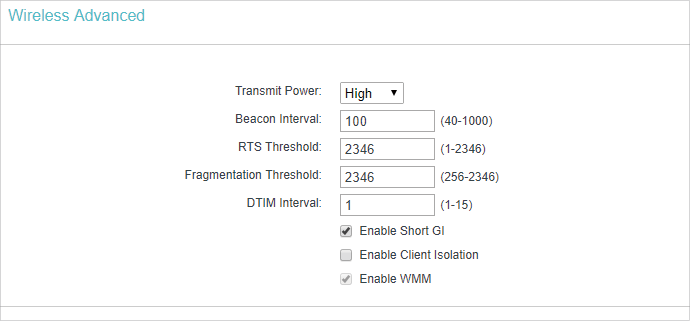
•Transmit Power - Select High, Middle or Low which you would like to specify for the router. High is the default setting and recommended.
•Beacon Interval - Enter a value between 40-1000 milliseconds for Beacon Interval here. Beacon Interval value determines the time interval of the beacons. The beacons are the packets sent by the router to synchronize a wireless network. The default value is 100.
•RTS Threshold - Here you can specify the RTS (Request to Send) Threshold. If the packet is larger than the specified RTS Threshold size, the router will send RTS frames to a particular receiving station and negotiate the sending of a data frame. The default value is 2346.
•Fragmentation Threshold - This value is the maximum size determining whether packets will be fragmented. Setting a low value for the Fragmentation Threshold may result in poor network performance because of excessive packets. 2346 is the default setting and is recommended.
•DTIM Interval - This value determines the interval of the Delivery Traffic Indication Message (DTIM). A DTIM field is a countdown field informing clients of the next window for listening to broadcast and multicast messages. When the router has buffered broadcast or multicast messages for associated clients, it sends the next DTIM with a DTIM Interval value. You can specify the value between 1-255 Beacon Intervals. The default value is 1, which indicates the DTIM Interval is the same as Beacon Interval.
•Enable Short GI - It is recommended to enable this function, for it will increase the data capacity by reducing the guard interval time.
•Enable Client Isolation - This function isolates all connected wireless stations so that wireless stations cannot access each other through WLAN. This function will be disabled if WDS/Bridge is enabled.
•Enable WMM - WMM function can guarantee the packets with high-priority messages being transmitted preferentially. It is strongly recommended to enable this function.
3.6. Wireless Statistics
1.Visit http://tplinkwifi.net, and log in with the username and password you set for the router.
2.Go to Wireless 2.4GHz/5GHz > Wireless Statistics to check the data packets sent and received by each client device connected to the router.

•MAC Address - The MAC address of the connected wireless client.
•Current Status - The running status of the connected wireless client.
•Received Packets - Packets received by the wireless client.
•Sent Packets - Packets sent by the wireless client.
•SSID - SSID that the wireless client is connected to.
Guest Network allows you to provide Wi-Fi access for guests without disclosing your main network. When you have guests in your home, apartment, or workplace, you can create a guest network for them.
1.Visit http://tplinkwifi.net, and log in with the username and password you set for the router.
2.Go to Guest Network.
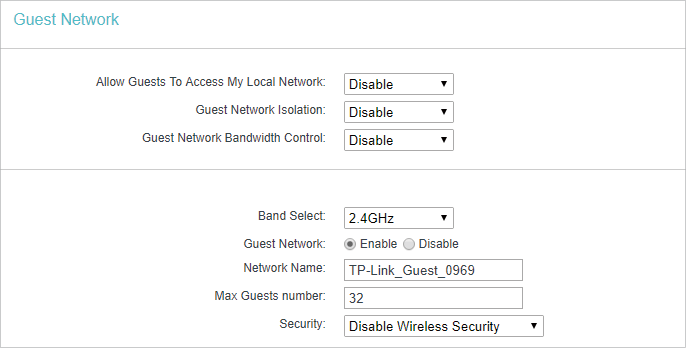
•Allow Guests To Access My Local Network - If enabled, guests can communicate with hosts.
•Guest Network Isolation - If enabled, one guest can not communicate with another.
•Guest Network Bandwidth Control - If enabled, the Guest Network Bandwidth Control rules will take effect.
•Band Select - Select the wireless band 2.4GHz or 5GHz for the guest network.
•Guest Network - Enable or disable the guest network .
•Network Name - Enter a value of up to 32 characters. The same Name(SSID) must be assigned to all wireless devices in your guest network.
•Max Guests number - Maximum guests (1-32).
•Security - You can configure the security of the guest network here.
•Access Time - You can also specify when or how long a guest device can access the internet.
•Schedule - During this time the wireless stations could not access the guest network.
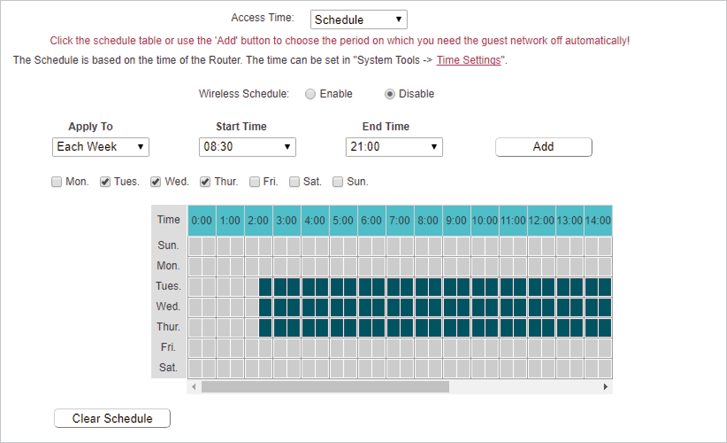
•Timeout - If the countdown timer hits zero, the guest network will be closed.
By default, the DHCP (Dynamic Host Configuration Protocol) Server is enabled and the router acts as a DHCP server; it dynamically assigns TCP/IP parameters to client devices from the IP Address Pool. You can change the settings of DHCP Server if necessary, and you can reserve LAN IP addresses for specified client devices.
5.1. DHCP Settings
1.Visit http://tplinkwifi.net, and log in with the username and password you set for the router.
2.Go to DHCP > DHCP Settings.
3.Specify DHCP server settings and click Save.
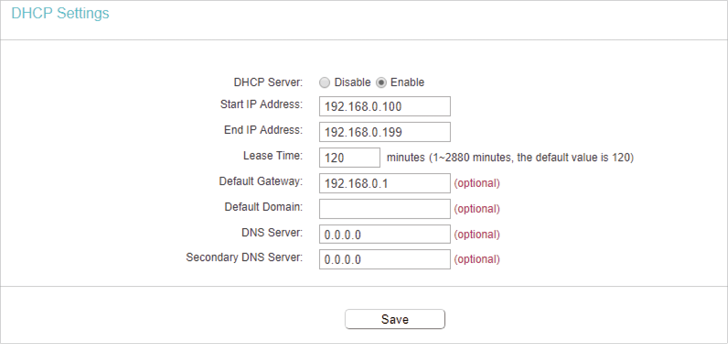
•DHCP Server - Enable or disable the DHCP server. If disabled, you must have another DHCP server within your network or else you must configure the computer manually.
•Start IP Address - Specify an IP address for the DHCP Server to start with when assigning IP addresses. 192.168.0.100 is the default start address.
•End IP Address - Specify an IP address for the DHCP Server to end with when assigning IP addresses. 192.168.0.199 is the default end address.
•Lease Time - The Address Lease Time is the amount of time a network user will be allowed to connect to the router with the current dynamic IP Address. When time is up, the router will automatically assign the same IP address to the user. The range of the time is 1 ~ 2880 minutes. The default value is 120.
•Default Gateway (Optional) - It is suggested to input the IP address of the LAN port of the Router. The default value is 192.168.0.254.
•Default Domain (Optional) - Input the domain name of your network.
•Primary DNS (Optional) - Input the DNS IP address provided by your ISP.
•Secondary DNS (Optional) - Input the IP address of another DNS server if your ISP provides two DNS servers.
![]() Note: To use the DHCP server function of the router, you must configure all computers on the LAN as Obtain an IP Address automatically.
Note: To use the DHCP server function of the router, you must configure all computers on the LAN as Obtain an IP Address automatically.
5.2. DHCP Client List
1.Visit http://tplinkwifi.net, and log in with the username and password you set for the router.
2.Go to DHCP > DHCP Client List to view the information of the clients connected to the router.

•Client Name - The name of the DHCP client.
•MAC Address - The MAC address of the DHCP client.
•Assigned IP - The IP address that the router has allocated to the DHCP client.
•Lease Time - The time of the DHCP client leased. After the dynamic IP address has expired, a new dynamic IP address will be automatically assigned to the user.
You cannot change any of the values on this page. To update this page and show the current connected devices, click Refresh.
5.3. Address Reservation
You can reserve an IP address for a specific client. When you have specified a reserved IP address for a PC on the LAN, this PC will always receive the same IP address each time when it accesses the DHCP server.
1.Visit http://tplinkwifi.net, and log in with the username and password you set for the router.
2.Go to DHCP > Address Reservation.
3.Click Add New and fill in the blanks.
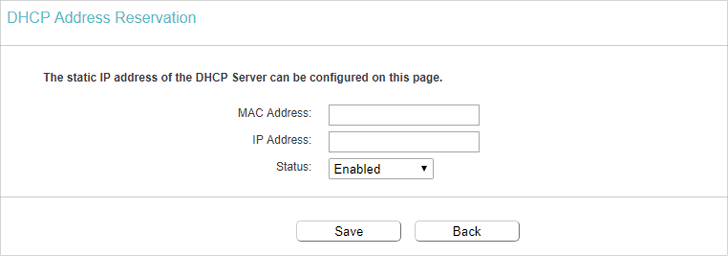
1 )Enter the MAC address (in XX:XX:XX:XX:XX:XX format) of the client for which you want to reserve an IP address.
2 )Enter the IP address (in dotted-decimal notation) which you want to reserve for the client.
3 )Leave the status as Enabled.
4 )Click Save.
You can insert a USB drive to share files among users on the LAN, access the USB drive remotely on the internet and enjoy videos and photos stored in the USB drive.
6.1. Storage Sharing
Share your USB storage device with different users on the network.
•To access the USB disk:
1.Connect Your USB Disk
Insert your USB storage device into the router’s USB port directly or using a USB cable. Wait several seconds until the USB LED becomes solid on.
Tips:
•If you use USB hubs, make sure no more than 2 devices are connected to the router.
•If the USB storage device requires using bundled external power, make sure the external power has been connected.
•If you use a USB hard drive, make sure its file system is FAT32 or NTFS.
•Before you physically disconnect a USB device from the router, safely remove it to avoid data damage: Go to USB Settings > USB Mass Storage and click Disconnect.
2.Access Your USB Disk
By default, all the network clients can access your USB disk. Refer to the following table for access instructions. You can customize user accounts by referring to User Accounts.
| Windows | Open the Windows Explorer (or go to Computer), type the server address \\tplinkwifi.net in the address bar, enter a username and password if required and then press [Enter].
|
| Mac | 1 )Click Go in the top left corner of the desktop and go to Connect to Server. 2 )Type the server address smb://tplinkwifi.net/volume1.
3 )Click Connect.
4 )When prompted, select the Guest radio box (If you have set up a username and password to deny anonymous access to the USB disk, you should select the Registered User radio box. To learn how to set up an account for the access, refer to User Accounts). |
| Tablet | Use a third-party app for network files management. |
•To customize your settings:
1.Visit http://tplinkwifi.net, and log in with the username and password you set for the router.
2.Go to USB Settings > Storage Sharing.
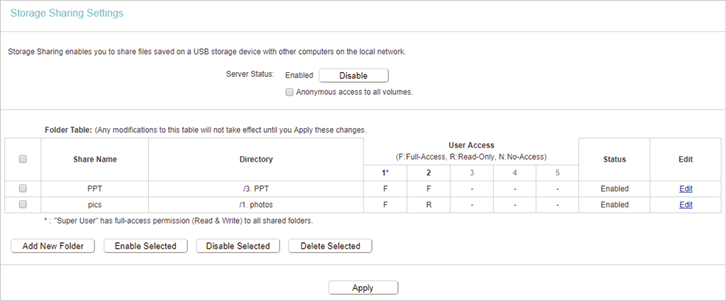
•Server Status - the Storage Sharing’s current status.
•Anonymous access to all volumes - This function is enabled by default, so users can access all activated volumes of Storage Sharing without accounts. If you want to add a shared folder which does not allow anonymous login, uncheck the box to disable this function. And Folder Table will be displayed as shown below.
•Share Name - This folder’s display name.
•Directory - The real full path of the specified folder.
•User Access - The authorization of the user is displayed. * users mean Super Users who have the full-access permission to all activated volumes and share folders. Grey users mean the users who have no right to use this function. Others are common users.
•Status - The status of the entry is enabled or disabled.
•Edit - Click Edit in the table, and then you can modify the entry.
6.2. FTP Server
You can share specific folders on you USB drive on the LAN or access your USB drive outside the local area network.
For example:
•Only share specific folders with clients on the LAN.
•Share photos and other large files with your friends without logging in to (and paying for) a photo-sharing site or email system.
•Get a safe backup for the material for a presentation.
•To set up your FTP server:

1.Insert your USB storage device into the router’s USB port directly or using a USB cable. Wait several seconds until the USB LED becomes solid on.
2.Visit http://tplinkwifi.net, and log in with the username and password you set for the router.
3.Go to USB Settings > FTP Server.
4.Click Enable to enable the FTP Server.
5.Click Enable to enable the internet access to the FTP server.
6.Specify a port number for the Service Port. The default value is 21.
7.Click Apply.
•To specify a folder to be accessed via the FTP server:
1.Visit http://tplinkwifi.net, and log in with the username and password you set for the router.
2.Go to USB Settings > FTP Server.
3.Click Add New Folder.
4.Specify a name for the folder to be shared in the Share Name field. And select the folder you want to share. And determine the access right of user accounts.
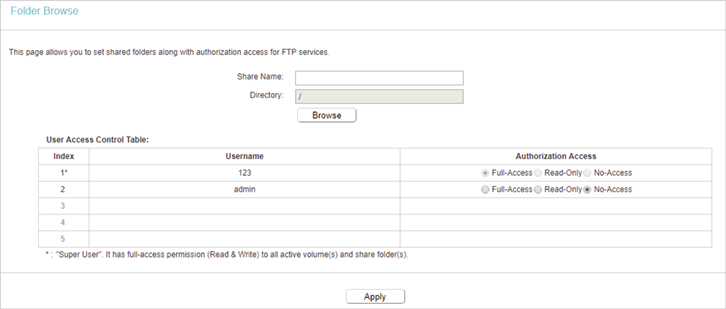
5.Click Apply.
6.You can check which folder is shared and also edit or delete the folder.

•To access the USB disk locally:
1.Connect Your USB Disk
Insert your USB storage device into the router’s USB port directly or using a USB cable. Wait several seconds until the USB LED becomes solid on.
Tips:
•If you use USB hubs, make sure no more than 2 devices are connected to the router.
•If the USB storage device requires using bundled external power, make sure the external power has been connected.
•If you use a USB hard drive, make sure its file system is FAT32 or NTFS.
•Before you physically disconnect a USB device from the router, safely remove it to avoid data damage: Go to USB Settings > USB Mass Storage and click Disconnect.
2.Access Your USB Disk Locally
Refer to the following table for access instructions. You can customize user accounts by referring to User Accounts.
| Windows | Open the Windows Explorer (or go to Computer), type the server address ftp://tplinkwifi.net in the address bar, enter a username and password and then press [Enter].
|
| Mac | 1 )Click Go in the top left corner of the desktop and go to Connect to Server. 2 )Type the server address ftp://tplinkwifi.net. 3 )Click Connect.
4 )When prompted, select the Registered User radio box and enter a username and password (To learn how to set up an account for the access, refer to User Accounts). |
| Tablet | Use a third-party app for network files management. |
•To access the USB disk remotely:
Refer to the following table for access instructions. You can customize user accounts by referring to User Accounts.
| Windows | 1 )Open the Windows Explorer (or go to Computer, only for Windows users) or open a web browser. 2 )Type the server address in the address bar: Type in ftp://<WAN IP address of the router>:<port number> (such as ftp://59.40.2.243:21). If you have specified a domain name for the router, you can also type in ftp://<domain name>:<port number> (such as ftp://MyDomainName:21)
The Windows Explorer (Windows 8) 3 )Press [Enter]. 4 )Access with the username and password by referring to User Accounts.
|
| Tablet | Use a third-party app for network files management. |
6.3. Media Server
The Media Server feature allows to view photos, play music and watch movies on the USB drive directly with DLNA-supported devices, such as on your computer, pad and PS2/3/4.
•To share specific folders:
1.Insert your USB storage device into the router’s USB port directly or using a USB cable. Wait several seconds until the USB LED becomes solid on.
2.Visit http://tplinkwifi.net, and log in with the username and password you set for the router.
3.Go to USB Settings > Media Server.
4.Click Enable to enable the Media Server.

5.Click Add New Folder. Specify a name for the folder to be shared in the Share Name field. And select the folder you want to share.
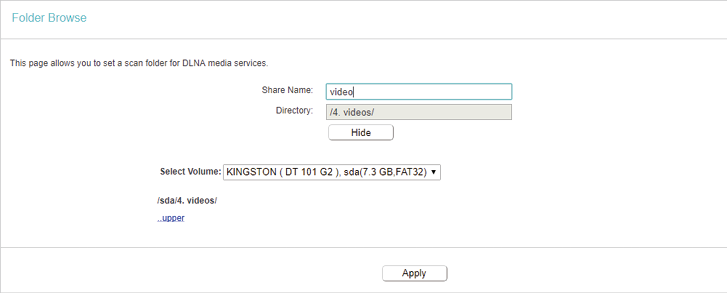
6.Click Apply.
•To access the USB disk:
1.Connect Your USB Disk
Insert your USB storage device into the router’s USB port directly or using a USB cable. Wait several seconds until the USB LED becomes solid on.
Tips:
•If you use USB hubs, make sure no more than 2 devices are connected to the router.
•If the USB storage device requires using bundled external power, make sure the external power has been connected.
•If you use a USB hard drive, make sure its file system is FAT32 or NTFS.
•Before you physically disconnect a USB device from the router, safely remove it to avoid data damage: Go to USB Settings > USB Mass Storage and click Disconnect.
2.Access the Media Files on Your USB Disk
Now the DLNA-supported devices (such as your computer and pad) connected to the router can detect and play the media files on the USB disk.
| Windows | •Go to Computer > Network, and click the Media Server Name in the Media Devices section.
|
| Tablet | •Use a third-party DLNA-supported player. |
You can specify the username and password for Storage Sharing and FTP Server access.
1.Visit http://tplinkwifi.net, and log in with the username and password you set for the router.
2.Go to USB Settings > User Accounts.
3.Choose the Index for the account and specify a new username and password in the New Username and New Password fields, and reenter the password for confirmation.
![]() Note: For an account with Index 1, it is the Super User with full access to all active volumes and shared folders.
Note: For an account with Index 1, it is the Super User with full access to all active volumes and shared folders.
4.Click Set.
5.You can check the newly added account and also edit or delete the account.

The router’s NAT (Network Address Translation) feature makes the devices on the LAN use the same public IP address to communicate in the internet, which protects the local network by hiding IP addresses of the devices. However, it also brings about the problem that external hosts cannot initiatively communicate with the specified devices in the local network.
With the forwarding feature, the router can traverse the isolation of NAT so that clients on the internet can reach devices on the LAN and realize some specific functions.
The TP-Link router includes four forwarding rules. If two or more rules are set, the priority of implementation from high to low is Virtual Servers, Port Triggering, UPNP and DMZ.
7.1. Virtual Servers
When you build up a server in the local network and want to share it on the internet, Virtual Servers can realize the service and provide it to internet users. At the same time virtual servers can keep the local network safe as other services are still invisible from the internet.
Virtual Servers can be used to set up public services in your local network, such as HTTP, FTP, DNS, POP3/SMTP and Telnet. Different service uses different service port. Port 80 is used in HTTP service, port 21 in FTP service, port 25 in SMTP service and port 110 in POP3 service. Please verify the service port number before the configuration.
I want to:
Share my personal website I’ve built in local network with my friends through the internet.
For example, the personal website has been built in my home PC (192.168.0.100). I hope that my friends on the internet can visit my website in some way. My PC is connected to the router with the WAN IP address 218.18.232.154.

How can I do that?
1.Set your PC to a static IP address, for example 192.168.0.100.
2.Visit http://tplinkwifi.net, and log in with the username and password you set for the router.
3.Go to Forwarding > Virtual Servers.
4.Click Add New. Select HTTP from the Common Service Port list. The service port, internal port and protocol will be automatically filled in. Enter the PC’s IP address 192.168.0.100 in the IP Address field.
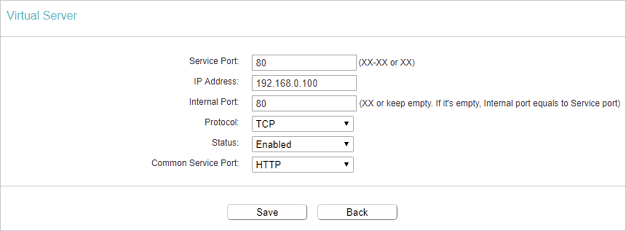
5.Leave the status as Enabled and click Save.
![]() Note:
Note:
•It is recommended to keep the default settings of Internal Port and Protocol if you are not clear about which port and protocol to use.
•If the service you want to use is not in the Common Service Port list, you can enter the corresponding parameters manually. You should verify the port number that the service needs.
•You can add multiple virtual server rules if you want to provide several services in a router. Please note that the Service Port should not be overlapped.
Done!
Users on the internet can enter http:// WAN IP (in this example: http:// 218.18.232.154) to visit your personal website.
![]() Note:
Note:
•If you have changed the default Service Port, you should use http:// WAN IP: Service Port to visit the website.
•Some specific service ports are forbidden by the ISP, if you fail to visit the website, please use another service port.
7.2. Port Triggering
Port triggering can specify a triggering port and its corresponding external ports. When a host in the local network initiates a connection to the triggering port, all the external ports will be opened for subsequent connections. The router can record the IP address of the host. When the data from the internet return to the external ports, the router can forward them to the corresponding host. Port triggering is mainly applied to online games, VoIPs, video players and common applications including MSN Gaming Zone, Dialpad, Quick Time 4 players and more.
Follow the steps below to configure the port triggering rules:
1.Visit http://tplinkwifi.net, and log in with the username and password you set for the router.
2.Go to Forwarding > Port Triggering.
3.Click Add New. Select the desired application from the Common Applications list. The trigger port amd incoming ports will be automatically filled in. The following picture takes application MSN Gaming Zone as an example.
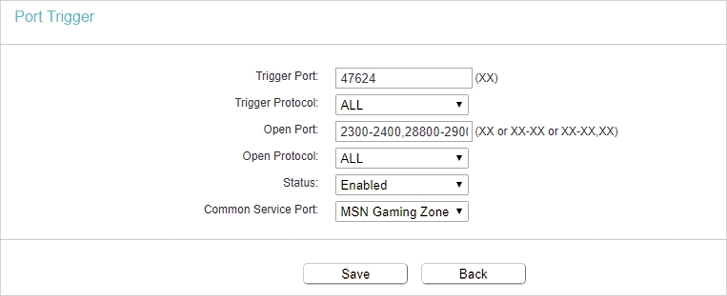
4.Leave the status as Enabled and click Save.
![]() Note:
Note:
•You can add multiple port triggering rules as needed.
•The triggering ports can not be overlapped.
•If the application you need is not listed in the Common Applications list, please enter the parameters manually. You should verify the incoming ports the application uses first and enter them in Incoming Ports field. You can input at most 5 groups of ports (or port sections). Every group of ports must be set apart with “,”. For example, 2000-2038, 2050-2051, 2085, 3010-3030.
7.3. DMZ
When a PC is set to be a DMZ (Demilitarized Zone) host in the local network, it is totally exposed to the internet, which can realize the unlimited bidirectional communication between internal hosts and external hosts. The DMZ host becomes a virtual server with all ports opened. When you are not clear about which ports to open in some special applications, such as IP camera and database software, you can set the PC to be a DMZ host.
![]() Note: DMZ is more applicable in the situation that users are not clear about which ports to open. When it is enabled, the DMZ host is totally exposed to the internet, which may bring some potential safety hazards. If DMZ is not in use, please disable it in time.
Note: DMZ is more applicable in the situation that users are not clear about which ports to open. When it is enabled, the DMZ host is totally exposed to the internet, which may bring some potential safety hazards. If DMZ is not in use, please disable it in time.
I want to:
Make the home PC join the internet online game without port restriction.
For example, due to some port restriction, when playing the online games, you can log in normally but cannot join a team with other players. To solve this problem, set your PC as a DMZ host with all ports opened.
How can I do that?
1.Assign a static IP address to your PC, for example 192.168.0.100.
2.Visit http://tplinkwifi.net, and log in with the username and password you set for the router.
3.Go to Forwarding > DMZ.
4.Select Enable and enter the IP address 192.168.0.100 in the DMZ Host IP Address filed.

5.Click Save.
Done!
You’ve set your PC to a DMZ host and now you can make a team to game with other players.
7.4. UPnP
The UPnP (Universal Plug and Play) protocol allows the applications or host devices to automatically find the front-end NAT device and send request to it to open the corresponding ports. With UPnP enabled, the applications or host devices on the local network and the internet can freely communicate with each other realizing the seamless connection of the network. You may need to enable the UPnP if you want to use applications for multiplayer gaming, peer-to-peer connections, real-time communication (such as VoIP or telephone conference) or remote assistance, etc.
Tips:
•UPnP is enabled by default in this router.
•Only the application supporting UPnP protocol can use this feature.
•UPnP feature needs the support of operating system (e.g. Windows Vista/ Windows 7/ Windows 8, etc. Some of operating system need to install the UPnP components).
For example, when you connect your Xbox to the router which is connected to the internet to play online games, UPnP will send request to the router to open the corresponding ports allowing the following data penetrating the NAT to transmit. Therefore, you can play Xbox online games without a hitch.

If necessary, you can follow the steps to change the status of UPnP.
1.Visit http://tplinkwifi.net, and log in with the username and password you set for the router.
2.Go to Forwarding > UPnP.
3.Click Disable or Enable according to your needs.

This function allows you to protect your home network from cyber attacks and unauthorized users by implementing these network security functions.
8.1. Basic Security
1.Visit http://tplinkwifi.net, and log in with the username and password you set for the router.
2.Go to Security > Basic Security, and you can enable or disable the security functions.
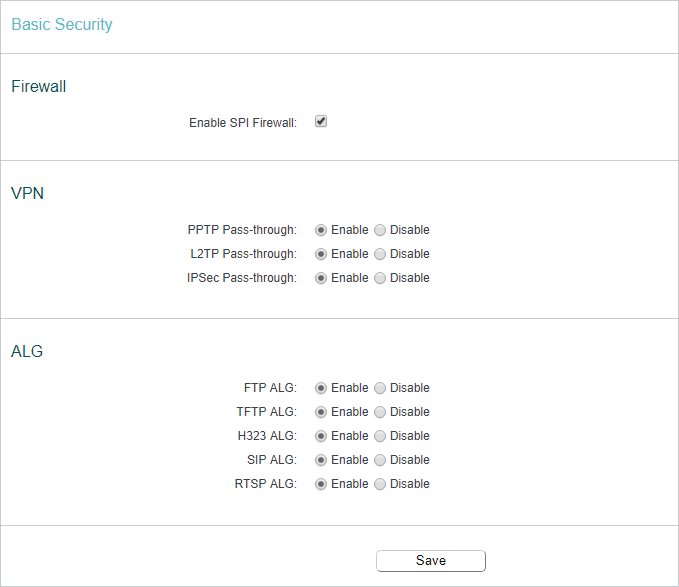
•Firewall - A firewall protects your network from internet attacks.
•SPI Firewall - SPI (Stateful Packet Inspection, also known as dynamic packet filtering) helps to prevent cyber attacks by tracking more state per session. It validates that the traffic passing through the session conforms to the protocol. SPI Firewall is enabled by default.
•VPN - VPN Passthrough must be enabled if you want to allow VPN tunnels using IPSec, PPTP or L2TP protocols to pass through the router’s firewall.
•PPTP Passthrough - Point-to-Point Tunneling Protocol (PPTP) allows the Point-to-Point Protocol (PPP) to be tunneled through an IP network. If you want to allow PPTP tunnels to pass through the router, you can keep the default (Enabled).
•L2TP Passthrough - Layer 2 Tunneling Protocol (L2TP) is the method used to enable Point-to-Point sessions via the internet on the Layer 2 level. If you want to allow L2TP tunnels to pass through the router, you can keep the default (Enabled).
•IPSec Passthrough - Internet Protocol Security (IPSec) is a suite of protocols for ensuring private, secure communications over Internet Protocol (IP) networks, through the use of cryptographic security services. If you want to allow IPSec tunnels to pass through the router, you can keep the default (Enabled).
•ALG - It is recommended to enable Application Layer Gateway (ALG) because ALG allows customized Network Address Translation (NAT) traversal filters to be plugged into the gateway to support address and port translation for certain application layer “control/data” protocols such as FTP, TFTP, H323 etc.
•FTP ALG - To allow FTP clients and servers to transfer data across NAT, keep the default Enable.
•TFTP ALG - To allow TFTP clients and servers to transfer data across NAT, keep the default Enable.
•H323 ALG - To allow Microsoft NetMeeting clients to communicate across NAT, keep the default Enable.
•SIP ALG - To allow some multimedia clients to communicate across NAT, click Enable.
•RTSP ALG - To allow some media player clients to communicate with some streaming media servers across NAT, click Enable.
3.Click Save.
8.2. Advanced Security
1.Visit http://tplinkwifi.net, and log in with the username and password you set for the router.
2.Go to Security > Advanced Security, and you can protect the router from being attacked by ICMP-Flood, UDP Flood and TCP-SYN Flood.
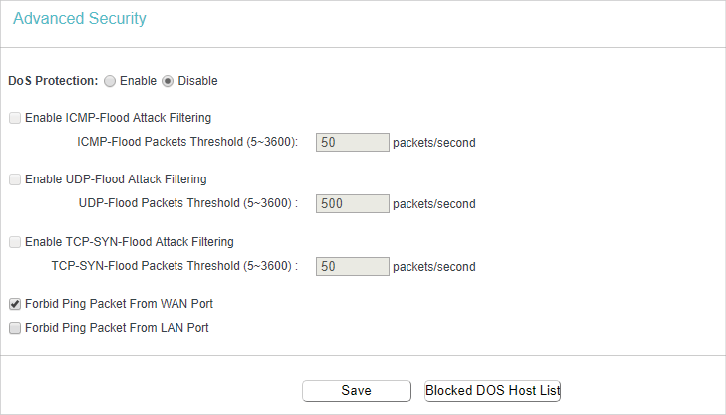
•DoS Protection - Denial of Service protection. Select Enable or Disable to enable or disable the DoS protection function. Only when it is enabled, will the flood filters be enabled.
![]() Note: Dos Protection will take effect only when the Statistics in System Tool > Statistics is enabled.
Note: Dos Protection will take effect only when the Statistics in System Tool > Statistics is enabled.
•Enable ICMP-FLOOD Attack Filtering -Check the box to enable or disable this function.
•ICMP-FLOOD Packets Threshold (5~3600) - The default value is 50. Enter a value between 5 ~ 3600. When the number of the current ICMP-FLOOD packets is beyond the set value, the router will startup the blocking function immediately.
•Enable UDP-FLOOD Filtering - Check the box to enable or disable this function.
•UDP-FLOOD Packets Threshold (5~3600) - The default value is 500. Enter a value between 5 ~ 3600. When the number of the current UPD-FLOOD packets is beyond the set value, the router will startup the blocking function immediately.
•Enable TCP-SYN-FLOOD Attack Filtering -Check the box to enable or disable this function.
•TCP-SYN-FLOOD Packets Threshold (5~3600) - The default value is 50. Enter a value between 5 ~ 3600. When the number of the current TCP-SYN-FLOOD packets is beyond the set value, the router will startup the blocking function immediately.
•Forbid Ping Packet From WAN Port - The default setting is disabled. If enabled, the ping packet from the internet cannot access the router.
•Forbid Ping Packet From LAN Port - The default setting is disabled. If enabled, the ping packet from LAN cannot access the router. This function can be used to defend against some viruses.
3.Click Save.
4.Click Blocked DoS Host List to display the DoS host table by blocking.
8.3. Local Management
1.Visit http://tplinkwifi.net, and log in with the username and password you set for the router.
2.Go to Security > Local Management, and you can block computers in LAN from accessing the router.
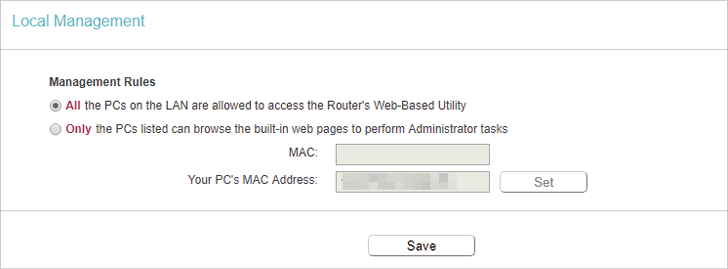
For example, if you want to allow PCs with specific MAC addresses to access the router’s web management page locally from inside the network, please follow the instructions below:
1 )Select Only the PCs listed can browse the built-in web pages to perform Administrator tasks.
2 )Enter the MAC address of each PC separately. The format of the MAC address is XX:XX:XX:XX:XX:XX (X is any hexadecimal digit). Only the PCs with the listed MAC addresses can use the password to browse the built-in web pages to perform administrator tasks.
3 )Click Set, and your PC’s MAC address will also be listed.
4 )Click Save.
![]() Note: If your PC is blocked but you want to access the router again, press and hold the Reset button to reset the router to the factory defaults.
Note: If your PC is blocked but you want to access the router again, press and hold the Reset button to reset the router to the factory defaults.
8.4. Remote Management
1.Visit http://tplinkwifi.net, and log in with the username and password you set for the router.
2.Go to Security > Remote Management, and you can manage your router from a remote device via the internet.

•Web Management Port - Web browser access normally uses the standard HTTP service port 80. This router’s default remote management web port number is 80. For higher security, you can change the remote management web port to a custom port by entering a number between 1 and 65534 but do not use the number of any common service port.
•Remote Management IP Address - This is the address you will use when accessing your router via a remote device. This function is disabled when the IP address is set to the default value of 0.0.0.0. To enable this function, change 0.0.0.0 to a valid IP address. If it is set to 255.255.255.255, then all the remote devices can access the router from the internet.
![]() Note:
Note:
•To access the router, enter your router’s WAN IP address in your browser’s address bar, followed by a colon and the custom port number. For example, if your router’s WAN address is 202.96.12.8, and the port number used is 8080, please enter http://202.96.12.8:8080 in your browser. Later, you may be asked for the router’s password. After successfully entering the username and password, you will be able to access the router’s web management page.
•Be sure to change the router’s default password for security purposes.
Parental Controls allows you to block inappropriate and malicious websites, and control access to specific websites at specific time for your children’s devices.
For example, you want the children’s PC with the MAC address 00:11:22:33:44:AA can access www.tp-link.com on Saturday only while the parent PC with the MAC address 00:11:22:33:44:BB is without any restriction.
1.Visit http://tplinkwifi.net, and log in with the username and password you set for the router.
2.Go to Parental Controls.
3.Select Enable Parental Controls and enter the MAC address 00:11:22:33:44:BB in the MAC Address of Parental PC field. And click Save.

4.Enter appropriate parameters in corresponding fields.
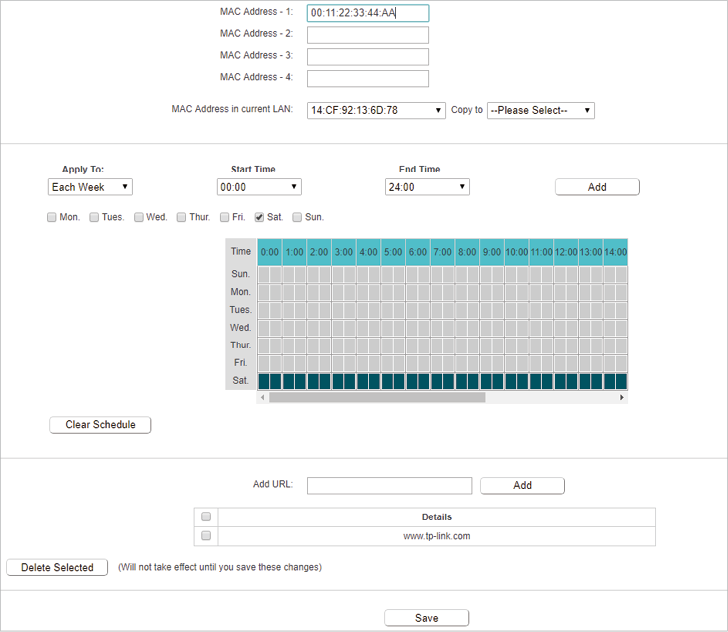
•Enter 00-11-22-33-44-BB in the MAC Address -1 field.
•Select the allowed access time.
•Enter www.tp-link.com in the Add URL field and click Add.
5.Click Save.
Access Control is used to deny or allow specific client devices to access your network with access time and content restrictions.
I want to:
Deny or allow specific client devices to access my network with access time and content restrictions.
For example, If you want to restrict the internet activities of host with MAC address 00:11:22:33:44:AA on the LAN to access www.tp-link.com only, please follow the steps below.
How can I do that?
1.Visit http://tplinkwifi.net, and log in with the username and password you set for the router.
2.Go to Access Control > Host and configure the host settings:
1 )Click Add New.
2 )Select MAC Address as the mode type. Create a unique description (e.g. host_1) for the host in the Host Description field and enter 00:11:22:33:44:AA in the MAC Address filed.

3 )Click Save.
3.Go to Access Control > Target and configure the target settings:
1 )Click Add New.
2 )Select URL Address as the mode type. Create a unique description (e.g. target_1) for the target in the Target Description field and enter the URL address, either the full name or the keywords (for example TP-Link) in the Add URL Address field and click Add.
![]() Note: Any domain name with keywords in it (e.g. www.tp-link.com) will be blocked or allowed.
Note: Any domain name with keywords in it (e.g. www.tp-link.com) will be blocked or allowed.
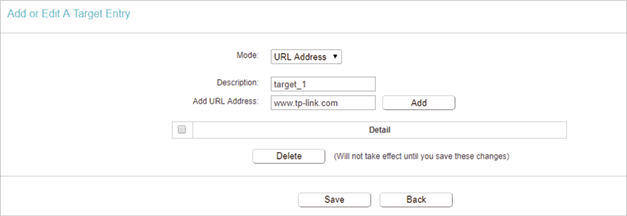
3 )Click Save.
4.Go to Access Control > Schedule and configure the schedule settings:
1 )Click Add New.
2 )Create a unique description (e.g. schedule_1) for the schedule in the Description field and set the applied time and click Add.
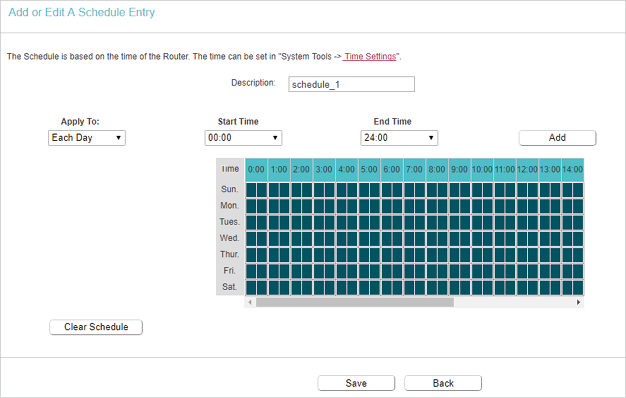
3 )Click Save.
5.Go to Access Control > Rule and add a new access control rule.
1 )Click Add New.
2 )Give a name for the rule in the Description field. Select host_1 from the host drop-down list; select target_1 from the target drop-down list; select schedule_1 from the schedule drop-down list.
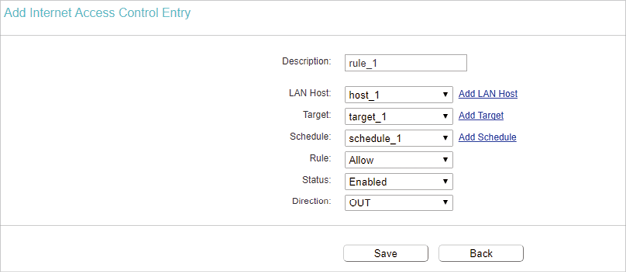
3 )Leave the status as Enabled as click Save.
6.Select Enable Internet access control to enable Access Control function.
7.Select Deny the packets not specified by any filtering rules to passthrough this device as the default filter rules and click Save.

Done!
Now only the specific host(s) can visit the target(s) within the scheduled time period.
Static Routing is a form of routing that is configured manually by a network administrator or a user by adding entries into a routing table. The manually-configured routing information guides the router in forwarding data packets to the specific destination.
11.1. Static Routing List
1.Visit http://tplinkwifi.net, and log in with the username and password you set for the router.
2.Go to Advanced Routing > Static Routing.
•To add static routing entries:
1. Click Add New.
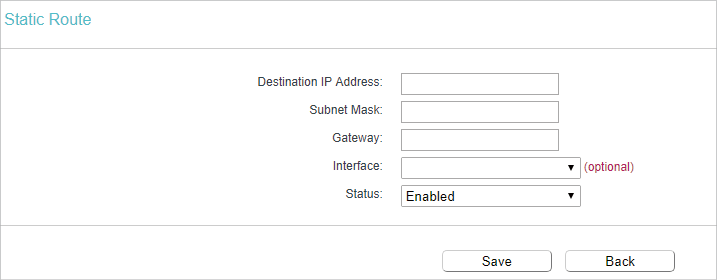
2.Enter the following information.
•Destination IP Address - The Destination IP Address is the address of the network or host that you want to assign to a static route.
•Subnet Mask - The Subnet Mask determines which portion of an IP address is the network portion, and which portion is the host portion.
•Gateway - This is the IP address of the default gateway device that allows the contact between the router and the network or host.
•Interface - It is empty by default. Please select a connection from the drop-down list if the Gateway is left empty or is not on the same network segment as LAN/WAN interface.
3.Select Enabled or Disabled for this entry on the Status drop-down list.
4.Click Save.
You can also do the following operations to modify the current settings.
•Click Delete Selected to delete selected entries.
•Click Enable Selected to enable selected entries.
•Click Disable Selected to disable selected entries.
11.2. System Routing Table
1.Visit http://tplinkwifi.net, and log in with the username and password you set for the router.
2.Go to Advanced Routing > System Routing Table, and you can view all the valid route entries in use.

•Destination Network - The Destination Network is the address of the network or host to which the static route is assigned.
•Subnet Mask - The Subnet Mask determines which portion of an IP address is the network portion, and which portion is the host portion.
•Gateway - This is the IP address of the gateway device that allows for contact between the Router and the network or host.
•Interface - This interface tells you whether the Destination IP Address is on the LAN & WLAN (internal wired and wireless networks), or the WAN (Internet).
•Click Refresh to refresh the data displayed.
1.Visit http://tplinkwifi.net, and log in with the username and password you set for the router.
2.Go to Bandwidth Control.
3.Configure the bandwidth as needed and click Save.

The values you configure for the Egress Bandwidth and Ingress Bandwidth should be less than 100,000Kbps. For optimal control of the bandwidth, please select the right Line Type and consult your ISP for the total egress and ingress bandwidth.
•Enable Bandwidth Control - Check this box so that the Bandwidth Control settings can take effect.
•Egress Bandwidth - The upload speed through the WAN port.
•Ingress Bandwidth - The download speed through the WAN port.

•Description - This is the information about the rules such as address range.
•Priority - Priority of Bandwidth Control rules. ‘1’ stands for the highest priority while ‘8’ stands for the lowest priority. The total Upstream/ Downstream Bandwidth is first allocated to guarantee all the Min Rate of Bandwidth Control rules. If there is any bandwidth left, it is first allocated to the rule with the highest priority, then to the rule with the second highest priority, and so on.
•Egress Bandwidth - This field displays the max and min upload bandwidth through the WAN port. The default is 0.
•Ingress Bandwidth - This field displays the max and min download bandwidth through the WAN port. The default is 0.
•Status - Rule status, show whether the rule takes effect.
•Edit - Choose to edit or delete an existing entry.
•To add a Bandwidth control rule:
1.Click Add New.
2.Enter the information as the figure shown below.
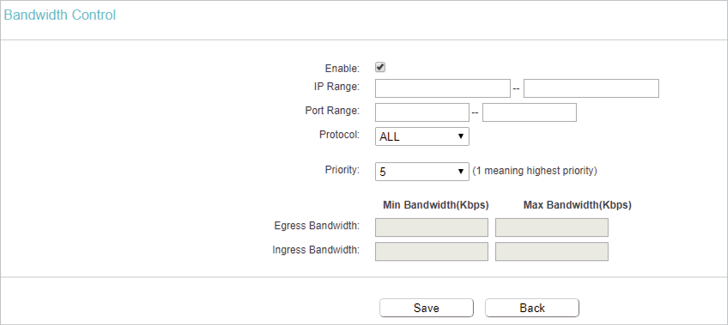
3.Click Save.
IP & MAC Binding, namely, ARP (Address Resolution Protocol) Binding, is used to bind a network device’s IP address to its MAC address. This will prevent ARP spoofing and other ARP attacks by denying network access to a device with a matching IP address in the ARP list, but with an unrecognized MAC address.
13.1. Binding Settings
1.Visit http://tplinkwifi.net, and log in with the username and password you set for the router.
2.Go to IP & MAC Binding > Binding Settings.
3.Select Enable for ARP Binding.

4.Click Save.
•To add IP & MAC Binding entries:
1.Click Add New.
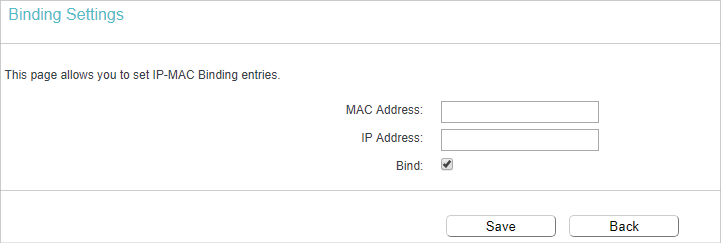
2.Enter the MAC address and IP address and select the Bind checkbox.
3.Click Save.
•To modify or delete an existing entry:
1.Find the desired entry in the table.
2.Click Edit or click Delete Selected.
13.2. ARP List
To manage a device, you can observe the device on the LAN by checking its MAC address and IP address on the ARP list, and you can also configure the items. This page displays the ARP list which shows all the existing IP & MAC Binding entries.

•MAC Address - The MAC address of the listed computer on the LAN.
•IP Address - The assigned IP address of the listed computer on the LAN.
•Status - Indicates whether or not the MAC and IP addresses are bound.
•Load Selected - Load selected items to the ARP list.
•Delete Selected - Delete selected items.
![]() Note: An item can not be loaded to the IP & MAC Binding list if the IP address of the item has been loaded before. Error warning will prompt as well.
Note: An item can not be loaded to the IP & MAC Binding list if the IP address of the item has been loaded before. Error warning will prompt as well.
The router offers the DDNS (Dynamic Domain Name System) feature, which allows the hosting of a website, FTP server, or e-mail server with a fixed domain name (named by yourself) and a dynamic IP address. Thus your friends can connect to your server by entering your domain name no matter what your IP address is. Before using this feature, you need to sign up for DDNS service providers such as www.comexe.cn,
www.dyndns.org, or www.noip.com. The Dynamic DNS client service provider will give you a password or key.
1.Visit http://tplinkwifi.net, and log in with the username and password you set for the router.
2.Go to Dynamic DNS.
Comexe DDNS
If the dynamic DNS Service Provider you select is www.comexe.cn, the following page will appear.
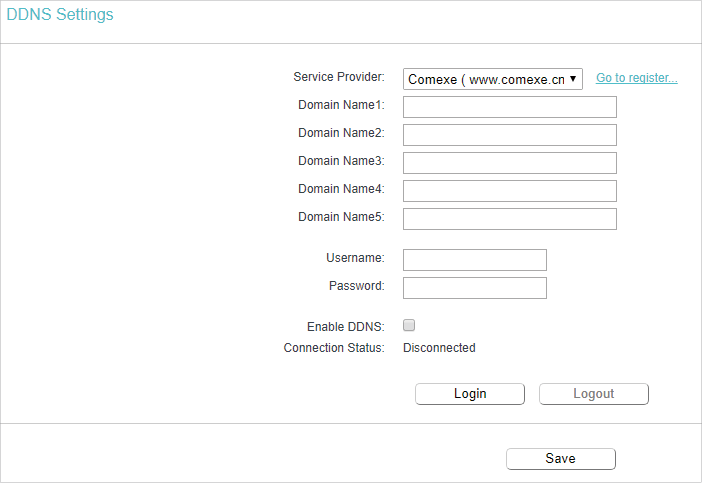
To set up for DDNS, follow these instructions:
1.Enter the Domain Name received from your dynamic DNS service provider.
2.Enter the Username for your DDNS account.
3.Enter the Password for your DDNS account.
4.Click Login.
5.Click Save.
•Connection Status - The status of the DDNS service connection is displayed here.
•Logout - Click Logout to log out of the DDNS service.
Dyndns DDNS
If the dynamic DNS Service Provider you select is www.dyn.com, the following page will appear.
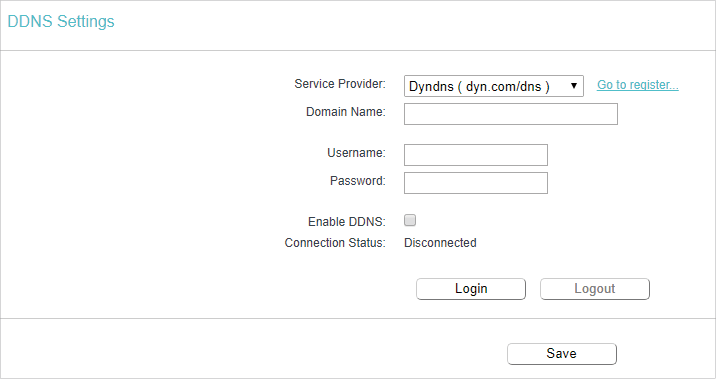
To set up for DDNS, follow these instructions:
1.Enter the Username for your DDNS account.
2.Enter the Password for your DDNS account.
3.Enter the Domain Name you received from dynamic DNS service provider here.
4.Click Login.
5.Click Save.
•Connection Status - The status of the DDNS service connection is displayed here.
•Logout - Click Logout to log out of the DDNS service.
No-ip DDNS
If the dynamic DNS Service Provider you select is www.noip.com, the following page will appear.
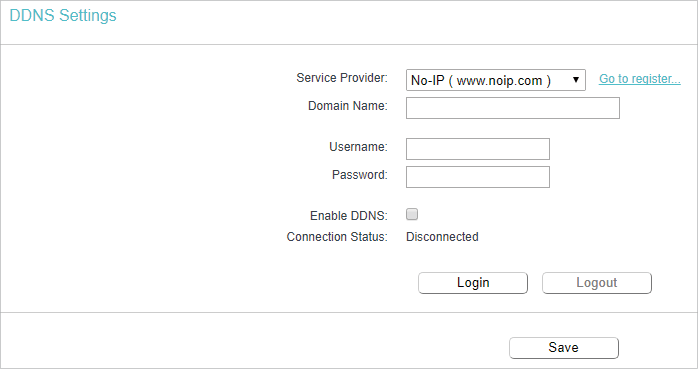
To set up for DDNS, follow these instructions:
1.Enter the Username for your DDNS account.
2.Enter the Password for your DDNS account.
3.Enter the Domain Name you received from dynamic DNS service provider.
4.Click Login.
5.Click Save.
•Connection Status - The status of the DDNS service connection is displayed here.
•Logout - Click Logout to log out of the DDNS service.
Your ISP provides information about one of the following IPv6 internet connection types: Dynamic IPv6, Static IPv6, PPPoEv6 and Tunnel 6to4.
1.Visit http://tplinkwifi.net, and log in with the username and password you set for the router.
2.Go to IPv6 > IPv6 WAN.
3.Enable IPv6 and select the internet connection type provided by your ISP.
![]() Note: If you do not know what your internet connection type is, contact your ISP or judge according to the already known information provided by your ISP.
Note: If you do not know what your internet connection type is, contact your ISP or judge according to the already known information provided by your ISP.
4.Fill in the blanks as required by different connection types.
1 )Dynamic IPv6: the router will automatically get related parameters from your ISP.
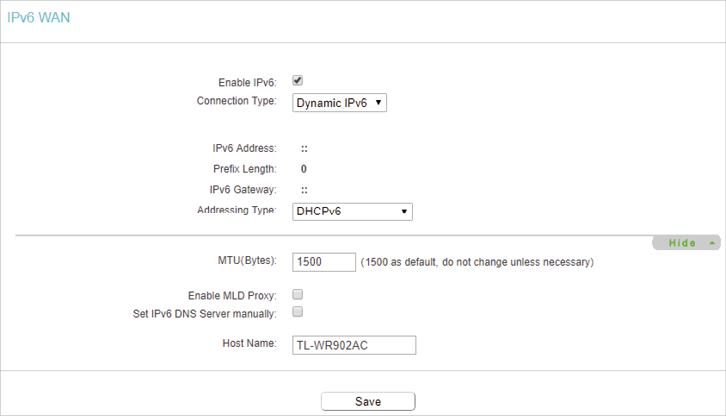
2 )Static IPv6: Fill in the IPv6 address, gateway (optional) and DNS servers (optional) and click Save.
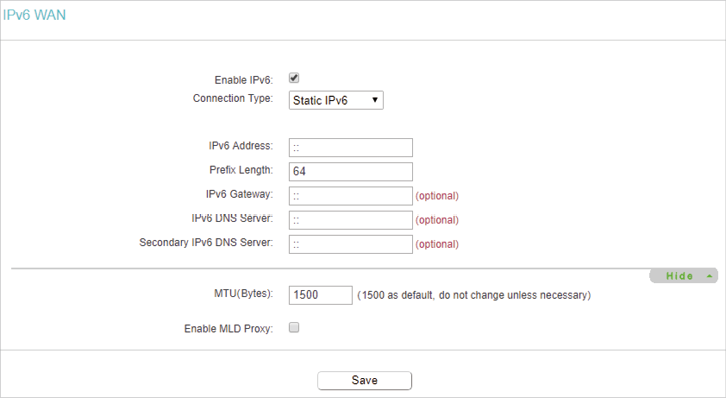
3 )PPPoEv6: By default, the router uses the IPv4 account to connect to the IPv6 server. Click Advance to input further information if your ISP requires.
![]() Note: If your ISP provides two separate accounts for the IPv4 and IPv6 connections, please untick the PPPoE same session with IPv4 connection checkbox and manually enter the username and password for the IPv6 connection.
Note: If your ISP provides two separate accounts for the IPv4 and IPv6 connections, please untick the PPPoE same session with IPv4 connection checkbox and manually enter the username and password for the IPv6 connection.
4 )Tunnel 6to4: An IPv4 connection type is a prerequisite for this connection type.

5.Configure the LAN settings. Select an Address Auto-Configuration Type to assign IPv6 addresses to the computers in your LAN. RADVD and DHCPv6 Server are provided. If RADVD is selected, it doesn’t need to be configured. If DHCPv6 Server is selected, please fill in the following parameters.
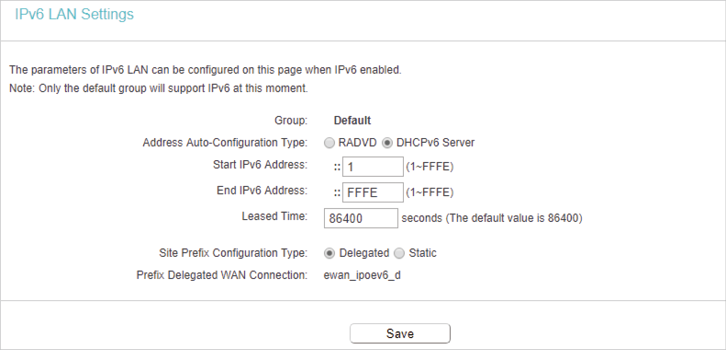
•Start IPv6 Address - Enter a value for the DHCPv6 server to start with when issuing IPv6 addresses.
•End IPv6 Address - Enter a value for the DHCPv6 server to end with when issuing IPv6 addresses.
•Leased Time - The Leased Time is the amount of time in which a network user will be allowed connection to the router with their current dynamic IPv6 address. Enter the amount of time, in hours, then the user will be leased this dynamic IPv6 address. After the dynamic IPv6 address has expired, the user will be automatically assigned a new dynamic IPv6 address. The default is 86400 seconds.
•Site Prefix Configuration Type - Select a type to assign IPv6 prefix addresses to the computers in your LAN. Delegated and Static are provided.
![]() Note: If your IPv6 wan connection type is “Tunnel 6to4”, the Site Prefix Configuration Type should be “Static” to make sure “Tunnel 6to4” works properly.
Note: If your IPv6 wan connection type is “Tunnel 6to4”, the Site Prefix Configuration Type should be “Static” to make sure “Tunnel 6to4” works properly.
1 )If Delegated is selected:
•Prefix Delegated WAN Connection - Displays the WAN connection selected to assign prefix.
2 )If Static is selected,
•Site Prefix - Enter a value for the site prefix.
•Site Prefix Length - Enter a value for the site prefix length.
6.Go to IPv6 > IPv6 Status to check whether you have successfully set up an IPv6 connection.
16.1. Time Settings
1.Visit http://tplinkwifi.net, and log in with the username and password you set for the router.
2.Go to System Tools > Time Settings and configure the system time as needed.
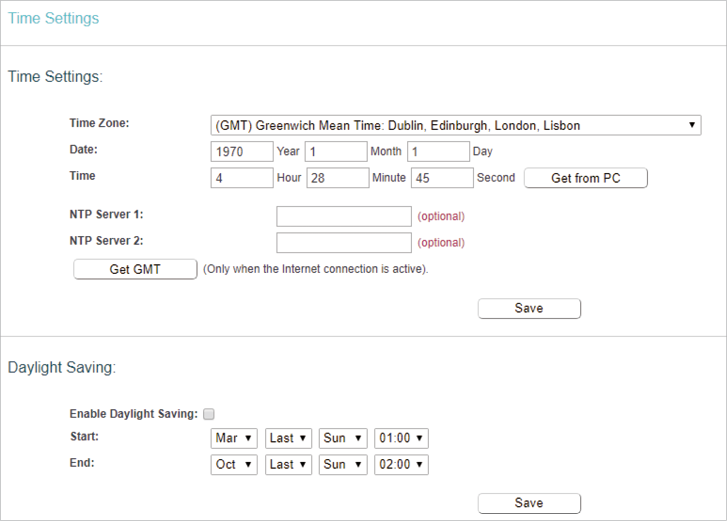
•To set time manually:
1.Select your local time zone.
2.Enter the Date in Month/Day/Year format.
3.Enter the Time in Hour/Minute/Second format.
4.Click Save.
•To set time automatically:
1.Select your local time zone.
2.Enter the address or domain of the NTP Server I or NTP Server II.
3.Click Get GMT to get time from the internet if you have connected to the internet.
•To set Daylight Saving Time:
1.Select Enable Daylight Saving.
2.Select the start time from the drop-down list in the Start field.
3.Select the end time from the drop-down list in the End field.
4.Click Save.
![]() Note: This setting will be used for some time-based functions such as firewall. You must specify your time zone once you log in to the router successfully; otherwise, time-based functions will not take effect.
Note: This setting will be used for some time-based functions such as firewall. You must specify your time zone once you log in to the router successfully; otherwise, time-based functions will not take effect.
16.2. Diagnostic
Diagnostic is used to test the connectivity between the router and the host or other network devices.
1.Visit http://tplinkwifi.net, and log in with the username and password you set for the router.
2.Go to System Tools > Diagnostic.
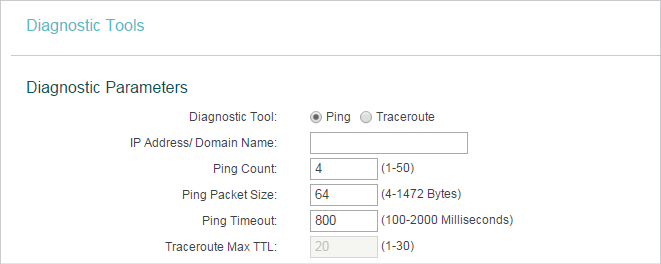
•Diagnostic Tool - Select one diagnostic tool.
•Ping - This diagnostic tool troubleshoots connectivity, reachability, and name resolution to a given host or gateway.
•Tracerouter - This diagnostic tool tests the performance of a connection.
![]() Note: You can use ping/traceroute to test both numeric IP address or domain name. If pinging/tracerouting the IP address is successful, but pinging/tracerouting the domain name is not, you might have a name resolution problem. In this case, ensure that the domain name you are specifying can be resolved by using Domain Name System (DNS) queries.
Note: You can use ping/traceroute to test both numeric IP address or domain name. If pinging/tracerouting the IP address is successful, but pinging/tracerouting the domain name is not, you might have a name resolution problem. In this case, ensure that the domain name you are specifying can be resolved by using Domain Name System (DNS) queries.
•IP address/Domain name - Enter the destination IP address (such as 192.168.0.1) or Domain name (such as www.tp-link.com).
•Pings Count - The number of Ping packets for a Ping connection.
•Ping Packet Size - The size of Ping packet.
•Ping Timeout - Set the waiting time for the reply of each Ping packet. If there is no reply in the specified time, the connection is overtime.
•Traceroute Max TTL - The max number of hops for a Traceroute connection.
3.Click Start to check the connectivity of the internet.
4.The Diagnostic Results page displays the diagnosis result. If the result is similar to the following figure, the connectivity of the internet is fine.
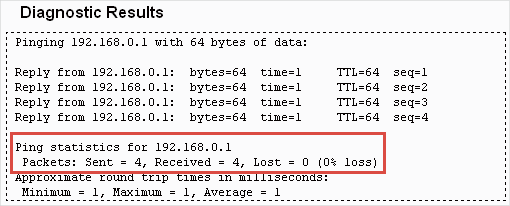
![]() Note: Only one user can use this tool at one time. Options “Number of Pings”, “Ping Size” and “Ping Timeout” are used for the Ping function. Option “Tracert Hops” is used for the Tracert function.
Note: Only one user can use this tool at one time. Options “Number of Pings”, “Ping Size” and “Ping Timeout” are used for the Ping function. Option “Tracert Hops” is used for the Tracert function.
16.3. Firmware Upgrade
TP-Link is dedicated to improving and richening the product features, giving users a better network experience. We will release the latest firmware at TP-Link official website. You can download the latest firmware file from the Support page of our website
www.tp-link.com and upgrade the firmware to the latest version.
1.Download the latest firmware file for the router from our website www.tp-link.com.
2.Visit http://tplinkwifi.net, and log in with the username and password you set for the router.
3.Go to System Tools > Firmware Upgrade.
4.Click Choose File to locate the downloaded firmware file, and click Upgrade.

16.4. Factory Defaults
1.Visit http://tplinkwifi.net, and log in with the username and password you set for the router.
2.Go to System Tools > Factory Defaults. Click Restore to reset all settings to the default values.

•The default Username: admin
•The default Password: admin
•The default IP Address: 192.168.0.1
•The default Subnet Mask: 255.255.255.0
16.5. Backup & Restore
The configuration settings are stored as a configuration file in the router. You can backup the configuration file in your computer for future use and restore the router to the previous settings from the backup file when needed.
1.Visit http://tplinkwifi.net, and log in with the username and password you set for the router.
2.Go to System Tools > Backup & Restore.

•To backup configuration settings:
Click Backup to save a copy of the current settings in your local computer. A “.bin“ file of the current settings will be stored in your computer.
•To restore configuration settings:
1.Click Choose File to locate the backup configuration file stored in your computer, and click Restore.
2.Wait a few minutes for the restoring and rebooting.
![]() Note: During the restoring process, do not power off or reset the router.
Note: During the restoring process, do not power off or reset the router.
16.6. Reboot
1.Visit http://tplinkwifi.net, and log in with the username and password you set for the router.
2.Go to System Tools > Reboot, and you can restart your router.
Some settings of the router will take effect only after rebooting, including:
•Change the LAN IP Address (system will reboot automatically).
•Change the DHCP Settings.
•Change the Web Management Port.
•Upgrade the firmware of the router (system will reboot automatically).
•Restore the router to its factory defaults (system will reboot automatically).
•Update the configuration with the file (system will reboot automatically).
16.7. Password
1.Visit http://tplinkwifi.net, and log in with the username and password you set for the router.
2.Go to System Tools > Password, and you can change the factory default username and password of the router.
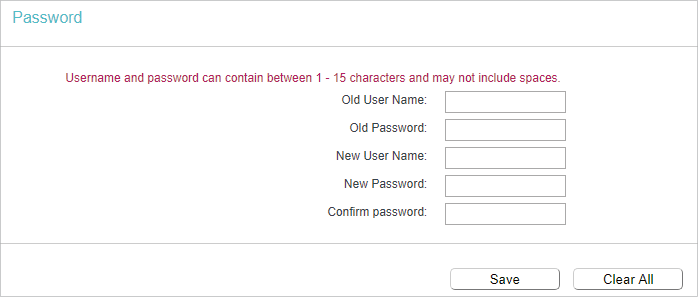
It is strongly recommended that you change the default username and password of the router, for all users that try to access the router’s web-based utility or Quick Setup will be prompted for the router’s username and password.
![]() Note: The new username and password must not exceed 15 characters and not include any spacing.
Note: The new username and password must not exceed 15 characters and not include any spacing.
3.Click Save.
16.8. System Log
1.Visit http://tplinkwifi.net, and log in with the username and password you set for the router.
2.Go to System Tools > System Log, and you can view the logs of the router.
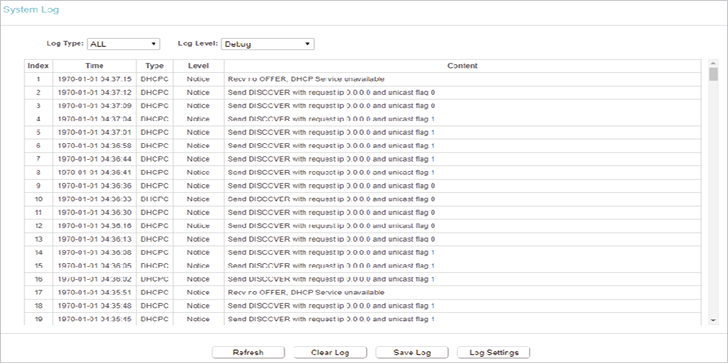
•Refresh - Refresh the page to show the latest log list.
•Clear Log - All the logs will be deleted from the router permanently, not just from the page.
•Save Log - Click to save all the logs in a txt file.
•Log Settings - Click to set the logs in the screen.
•Save Locally - If Save Locally is selected, events will be recorded in the local memory.
•Minimum Level - Select the Minimum level in the drop-down list, for the Minimum Level, all logged events above or equal to the selected level will be displayed.
•Save Remotely - If Save Remotely is selected, events will be sent to the specified IP address and UDP port of the remote system log server.
16.9. Statistics
1.Visit http://tplinkwifi.net, and log in with the username and password you set for the router.
2.Go to System Tools > Statistics, and you can view the statistics of the router, including total traffic and the value of the last Packet Statistic Interval in seconds.
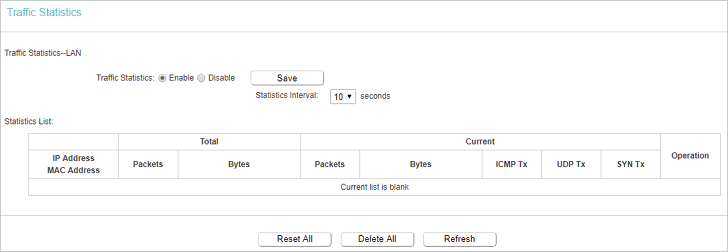
•Traffic Statistics - Enable or Disable. The default value is disabled. To enable, click the Enable button. If disabled, the function of DoS protection in Security settings will disabled.
•Statistics Interval - The default value is 10. Select a value between 5 and 60 in the drop-down list. The Packets Statistic Interval indicates the time section of the packets statistic.
•Click Refresh to refresh immediately.
•Click Reset All to reset the values of all the entries to zero.
•Click Delete All to delete all entries in the table.
Statistics Table
| IP/MAC Address | The IP and MAC address are displayed with related statistics. | |
| Total | Packets | The total number of packets received and transmitted by the router. |
| Bytes | The total number of bytes received and transmitted by the router. | |
| Current | Packets | The total number of packets received and transmitted in the last Packets Statistic interval seconds. |
| Bytes | The total number of bytes received and transmitted in the last Packets Statistic interval seconds. | |
| ICMP Tx | The number of the ICMP packets transmitted to WAN per second at the specified Packets Statistics interval. It is shown like “current transmitting rate / Max transmitting rate”. | |
| UDP Tx | The number of UDP packets transmitted to the WAN per second at the specified Packets Statistics interval. It is shown like “current transmitting rate / Max transmitting rate”. | |
| TCP SYN Tx | The number of TCP SYN packets transmitted to the WAN per second at the specified Packets Statistics interval. It is shown like “current transmitting rate / Max transmitting rate”. | |
| Operation | Reset | Reset the value of the entry to zero. |
| Delete | Delete the existing entry in the table. | |
Click Logout at the bottom of the main menu, and you will log out of the web management page and return to the login window.

